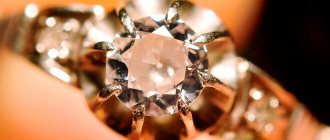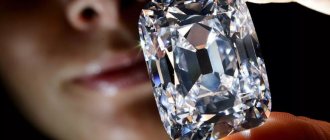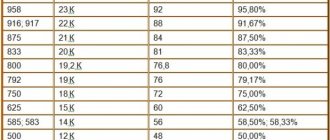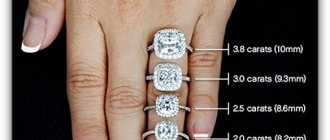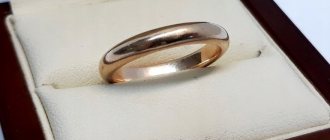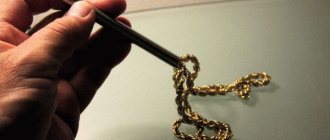Precious minerals, due to their splendor and radiant shine, have always attracted the eyes of people and become objects of admiration. However, what makes stones so expensive is not only their external beauty, but also their rarity. The cost of unique specimens reaches sky-high levels.
An equally important parameter for setting the price is the weight of the mineral. To measure the mass of precious stones, a non-standard unit is used - the carat, which is well known to jewelers. However, for an uninformed person, the weight of a carat in grams remains a mystery, so before buying expensive jewelry inlaid with diamonds or sapphires, you should know how much one carat weighs and how to determine the number of grams in a gem.
What is carat
To measure the mass of precious stones, the carat is used - a unit that has the designation ct and is equal to 0.2 grams. In England, the same value is used to determine the percentage of gold in the setting, but in this case the unit is abbreviated “K”.
It is important to note that the size of a gem is not measured in ct, since this is a unit of mass, not dimensions. In addition, the parameters of the jewelry insert largely depend on the cutting method by which the crystals take shape.
To determine the cost and value of a mineral, one must know how many cts are contained in a particular sample. When purchasing, do not forget that purity also affects the price, so more does not always mean better.
Value Share Calculation
To establish the mass, the jeweler uses linear technologies and calculation methods. The formula used is: M(Kr-57) = D2 x H x 0.0061 + correction. The D-value will represent the diameter of the stone, and the H will indicate its height. Therefore, speaking of mathematical deductions, linear measurements are also found in this art. For example, a 1 carat diamond needs to be measured to obtain the diameter and height data. If its shape is round, then you need to make corrections to the initial data and those that will be received later. The type of cut is also important:
- Girdle thickness.
- Culet size.
- Primary processing.
- Major losses.
In practice, the correction can be up to 17% after visual inspection of the jewelry. The buyer should understand that a 1-carat diamond ring will have approximate calculation data, since the error of calculation methods also introduces adjustments and adjustments of up to 9-10%.
History of the unit
The history of the origin of the carat as a unit of measurement goes back to earlier times. In the old days there were no scales, so merchants and jewelry dealers had difficulty selling jewelry by original weight. A unified measurement system was invented that compares the size and mass of minerals.
To determine the weight of gems, grains of carato, a ceratonia plant that grew in the area where mineral mining took place, began to be used. In other countries, acacia grains were used as weights. However, the name “carat” owes its appearance to ceratonia. The fact is that the fruits of this tree had the same mass - 0.19 grams - regardless of the place of growth and time.
The measurement was officially agreed upon in 1907 during the Fourth General Conference.
In the USSR, official approval was received in 1922. From that moment on, the mass of jewelry began to be determined in ct.
Where to find the stamp, sample and manufacturer's mark on the product
Each ring, bracelet, chain and other jewelry must correspond to the standard, one of the existing rating systems. Any jewelry salon can only sell jewelry that bears the state hallmark. This imprint is called a name tag and includes numbers and letters. The numbers indicate the year of manufacture and sample. The letter symbol indicates the manufacturer.
Any jewelry is sold with a label, details: name of the manufacturer, name of the jewelry, code, article number, weight. Additionally, the size of the item and the name of the inserts, if any, are indicated. According to GOST, the label is attached to the products with white thread and a seal.
Marking on a product is regulated and carried out only by the Assay Chamber of the Ministry of Finance of the Russian Federation. The state mark can be affixed using a laser or minted. The presence of such a sign indicates the authenticity of the jewelry and the passage of appropriate checks.
Includes a sample, a sign of identification, which are applied in one or different images. The ID symbol can be an image of a star with a hammer and sickle, characteristic of Soviet gold, or the head of a woman in a kokoshnik, turned to the right.
Kinds
In the modern world, there are two types of units for measuring the mass of jewelry - metric and assay carat. The first is a measure of the weight of precious stones, the second determines the purity of the gold alloy.
Metric
The metric carat is a unit of measure adopted in all developed countries. Metric cts are used to measure the mass of unique and dazzling diamonds. The history of the origin of the unit of measurement goes back to antiquity, where the mass of minerals was determined using ceratonia fruits, which have an identical weight - 189 mg.
Difficulties began when traders discovered that the fruits differed in different countries. This created inconvenience and caused conflicts between merchants. As a result, the idea of adopting a single unit of mass arose, but this was opposed by Great Britain, which adhered to its metric system. Despite the difficulties, the jewelers soon agreed on a single ct - 0.2 grams.
Assay
This type is different from the metric carat and denotes a measure not of weight, but of the purity of the gold alloy. The hallmark carat was invented in Ancient Rome, when the emperor introduced a gold coin that weighed 24 K. A similar coin is still in active circulation in Great Britain. Other countries prefer to use percentages, for example, the 585-carat designation indicates that the jewelry contains 58.5% pure gold.
When using an assay unit to determine the purity of gold, the following ratio is taken: 24K is the pure metal content. Therefore, a piece containing half gold would be 12K. In Russia, the jewelry industry produces jewelry with hallmarks of 750, 585, and 375—18, 14, and 9 K, respectively.
Carat and fineness of standard gold on the world market
The carat rate for valuing jewelry is used by America, Great Britain, Switzerland and other European countries.
The gold standard on the world market is considered to be 24 carats. Every day, the price of gold is determined on the precious metals exchange precisely in relation to bank bullion, which consists of 99.99% of the precious metal. The purity of such gold reserves is 999.
Using a simple example of calculating the ligature, you can understand how the standard and carats relate. To find out how much ligature the alloy contains, you need to subtract the number of carats on the stamp from 24k. 12k jewelry uses 12k other metals. This simple translation allows us to equate carats to a metric indicator, in which 1000 grams (24k) consists of 500 grams of gold (12k) and 500 grams of alloy (12k). Accordingly, 12k = sample 500.
Difference between gold and diamond carats
To answer the question of how diamond carats differ from gold carats, it should be understood that these two definitions are used for different purposes:
- Diamond (metric) carats are used to indicate the weight of minerals, which include famous diamonds. The weight of one carat is 0.2 grams, the designation is ct.
- Gold (assay) standards determine the amount of pure gold and have the abbreviation K. In some countries, for example, in Russia, jewelry is made with hallmarks that can easily be converted to K.
The system for measuring the weight of gems and the gold content goes back to ancient times and is still used today. In the jewelry industry, carat scales with minimal error are used to determine weight in grams. To calculate carat content, there are many tables with the help of which even a person ignorant in this area can calculate the number of grams.
Other similar abbreviations.
There are other abbreviations used to indicate the total carat weight of diamond jewelry.
You will sometimes see the abbreviation DTW (or "dtw") imprinted on rings or other jewelry set with diamonds. DTW simply means “diamond total weight”—essentially the same meaning as CTW.
Another abbreviation that means the same thing is TW (or "tw"), which is an abbreviation for "total weight."
So if you see markings like 2 CTW, 2 DTW or 2 TW, you should know that they all mean the same thing.
How many grams in one carat
At the beginning of the 20th century, jewelers agreed on the exact number of grams in a carat. In 1907, they decided to equate the weight of one carat to 0.2 grams. However, not all countries agreed to convert the mass into carats, continuing to use their own values. The countries adopted a unified standard in the following sequence:
- France - 1907
- Holland - 1911
- USA - 1913
- USSR - 1923
Following these states, other countries also decided to convert grams to carats. However, a 1 ct gem is a rare and expensive stone. Much more often you come across crystals with a smaller mass, not reaching 0.2 grams. But here, too, jewelers did not use standard measures and created their own unit - the point. It has been established that one ct (0.2 grams) is equal to 100 points.
Why is it better to trust the sample on the product?
Each piece of jewelry of domestic or imported origin must have the necessary markings. Imported gold jewelry is always marked with carats and the word “gold”. Certificates for trading are required.
It is important to correctly read the existing name tag, especially on products brought from other countries. After all, most of such jewelry is gold-plated jewelry or silver, which is also indicated by the presence of appropriate markings. Moreover, the price of these jewelry may correspond to the original.
Any gold jewelry brought for sale in the Russian Federation requires assaying. Then the fineness is indicated along with the carats.
How do the mass and diameter of precious gems relate?
Before visiting a jewelry store, a table of the ratio of the diameter, which is measured in millimeters or centimeters, and the weight of the mineral will help you find out approximately the cost of the stone. It is difficult to know the exact weight of a particular specimen, since the gems that go on sale have different cuts. At the same time, the primary goal of every jeweler is to maintain the weight of the original crystal, so gems of the same diameter can weigh differently.
The table will help you understand the intricacies of the relationship between carat and diameter (mm):
| Diameter in mm | Carat weight |
| 4,1 | 0,25 |
| 5,1 | 0,5 |
| 6,4 | 1 |
| 8,2 | 2 |
| 9,4 | 3 |
| 10,4 | 4 |
| 11 | 5 |
| 14 | 10 |
| 16 | 15 |
Similar tables that exist for each jewelry variety of stones allow you to find out the number of grams without removing the precious insert from the ring or earrings.
Table: ratio of different rating systems
| System | Carat | Metric |
| Zolotnikovaya | ||
| 36 | 9 | 375 |
| 48 | 12 | 500 |
| 56 | 14 | 585 |
| 72 | 18 | 750 |
| 88 | 22 | 900 |
| 92 | 23 | 958 |
| 96 | 24 | 999 |
Gold ring with a stamp 56
Determining the carat value of a product using the acid method. Instructions
Using simple methods, you can establish the authenticity of gold. But how to determine the sample or carat? It is difficult to do this at home, since you will have to purchase special reagents. A jeweler can use the acid method to determine the purity of items. It is also used in pawnshops, buying precious items. To do this, a small scratch is made on the jewelry, onto which a little acid is dripped, which reacts with the noble metal. Based on the result, you can determine how many carats the product corresponds to.
Step by step test execution:
- Clean the product from dirt and make a small scratch.
- Take reagents intended for different carats. First, apply a drop from the bottle with the lowest reading onto the scratch. If the carat value is higher than that indicated on the bottle, the color of the alloy will not change. Then the experiment must be repeated until a match is found.
- When the carat value of the reagent matches the precious metal, the location of the damage will slightly change the shade. If the value of the jewelry differs by several carats, the scratch will be covered with light rust. If the alloy has a quality several carats higher than indicated on the bottle, then the scratch will dissolve and disappear.
